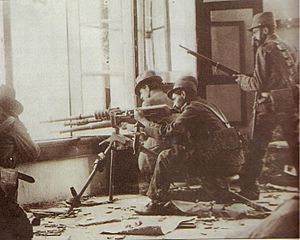Ten Tragic Days facts for kids
Quick facts for kids Ten Tragic Days |
|||||||
|---|---|---|---|---|---|---|---|
| Part of the Mexican Revolution | |||||||
 Rebel followers of Félix Díaz in the Mexico City YMCA during the coup against Madero |
|||||||
|
|||||||
| Belligerents | |||||||
| (Loyalists) Maderistas |
(Rebels) Porfiristas Reyistas Felicistas Supported by: |
||||||
| Commanders and leaders | |||||||
| Lauro Villar Ángel Ortiz Monasterio Victoriano Huerta (9-12 February) Ángel García Peña (WIA) Felipe Ángeles |
Félix Díaz Bernardo Reyes † Manuel Mondragón Aureliano Blanquet Gregorio Ruiz † Victoriano Huerta (12-19 February) |
||||||
| Casualties and losses | |||||||
| 5,500 dead | |||||||
| Victoriano Huerta switched from Pro-Madero to Anti-Madero during the fighting | |||||||
The Ten Tragic Days (La Decena Trágica in Spanish) was a major event during the Mexican Revolution. It was a sudden takeover of power, called a coup d'état, that happened in Mexico City. This event lasted for ten days, from February 9 to February 19, 1913. It led to a new and difficult part of the Mexican Revolution, which lasted from 1910 to 1920.
Contents
What Were the Ten Tragic Days?
This event was a plan by people who did not like Francisco I. Madero, who was the elected president of Mexico. Their goal was to make things seem so chaotic that Madero would have to give up his presidency.
The Plan to Overthrow Madero
Rebel leaders, General Félix Díaz and General Bernardo Reyes, escaped from jail. Félix Díaz was the nephew of the former president, Porfirio Díaz. These generals gathered their forces to try and remove President Madero from power. The U.S. Ambassador to Mexico, Henry Lane Wilson, strongly supported this plan. He really wanted Madero out of office.
President Madero had kept the Mexican Federal Army after the previous president, Porfirio Díaz, was forced to resign. The leader of this army was General Victoriano Huerta. At first, Huerta was supposed to defend Madero's government. However, he secretly joined the rebels. These rebels wanted to bring back the old way of governing Mexico.
Violence in Mexico City
On February 18, President Madero and his Vice President, José María Pino Suárez, were captured by rebel General Aureliano Blanquet. This effectively ended Madero's time as president. The next day, February 19, General Díaz and General Huerta argued about who should lead the new government. Ambassador Wilson helped them reach an agreement at the U.S. embassy. This agreement was called the Pact of the Embassy.
For the regular people living in Mexico City, these ten days were terrible. There was a lot of bombing and shooting. Most of the fighting was between the two military groups. But artillery and rifle fire also hurt many innocent people. It also caused a lot of damage to buildings in the city center.
The End of the Ten Days
The agreement between the two rebel generals on February 19 stopped the violence in Mexico City. This marked the end of the Ten Tragic Days. But the political problems continued. While they were held captive, Madero and his vice president resigned. They thought they would be allowed to leave the country. However, they were sadly killed on February 22, 1913.
What Happened After?
General Huerta then became the President of Mexico. He had the support of the U.S. and German ambassadors. Most of Mexico's state governors also supported him. But many people were very upset about Huerta's takeover and the killings. This led to a civil war. Huerta's government fought against revolutionary forces in northern and southern Mexico.
Madero's Legacy
Madero's death shocked many Mexicans. The new U.S. President, Woodrow Wilson, also refused to recognize Huerta's government. Madero's assassination quickly made him a hero, or "martyr," to many. His death became a very important part of Mexico's history.
Huerta was recognized by most state governors in Mexico. But Venustiano Carranza, the governor of Coahuila, refused to accept Huerta. Carranza started a rebellion against Huerta. He brought together a group from northern Mexico to remove Huerta's government. The coup in Mexico City caused many uprisings. These groups eventually formed the Constitutionalist Army. This army was the final winner of the Mexican Revolution. The Ten Tragic Days was the last time a Mexican president was successfully overthrown by a coup.
The New President Huerta
After Madero's death, his wife tried to get his body back. On February 24, Madero was buried in a private grave in Mexico City. His family then left the country. Madero's body stayed there until it was moved to the Monument to the Revolution in 1938.
Photos from the Time
Because these events happened in the capital city, many photographers were there. They took a large number of pictures during this time. These photos are very important historical records. They show the soldiers fighting, but also the regular people. In books and collections about the Revolution, photos of these events are often included. They help us understand the impact on civilians. A digital collection at Southern Methodist University has 43 photos from a private album. These are a great visual source.
See also
 In Spanish: Decena Trágica para niños
In Spanish: Decena Trágica para niños

